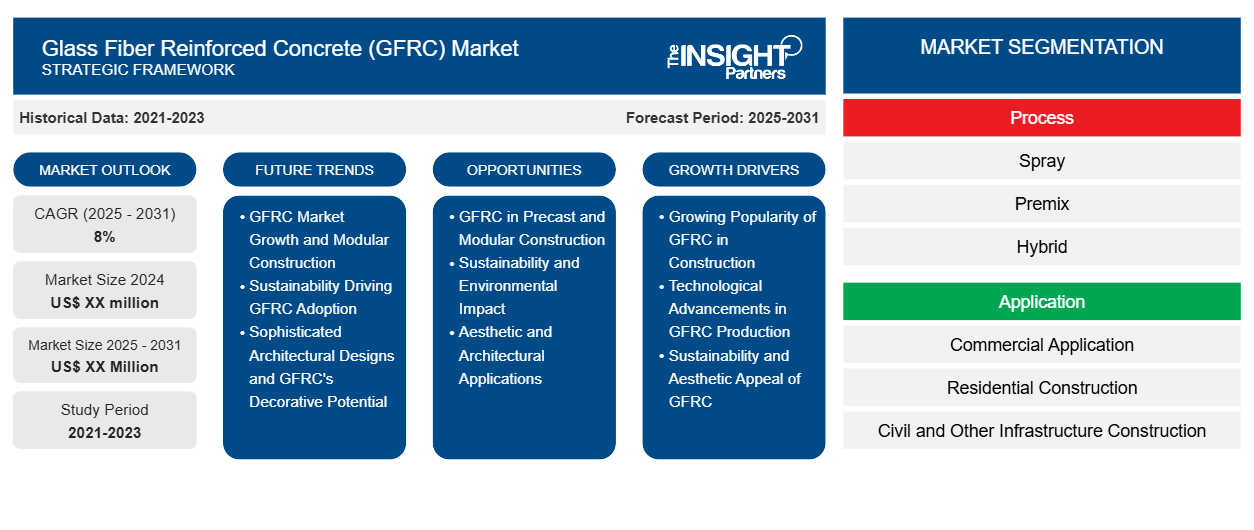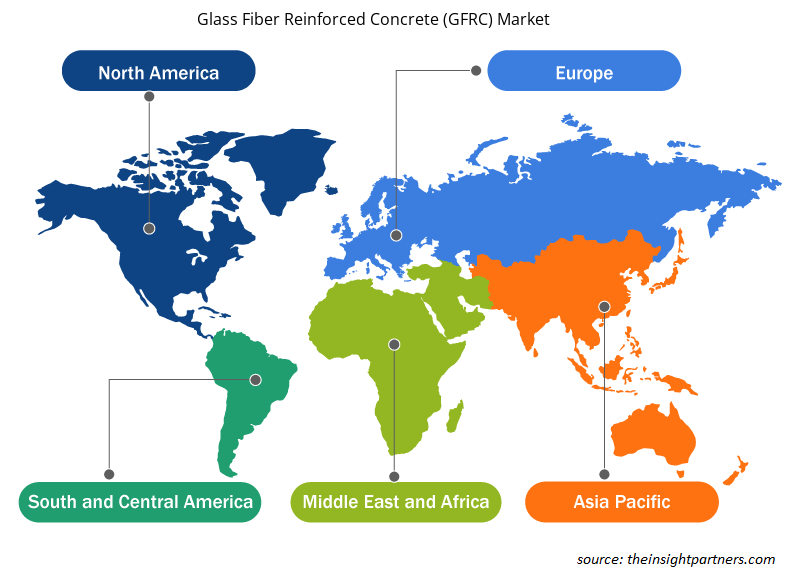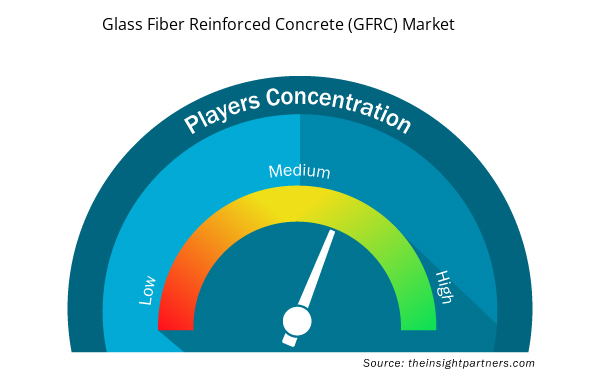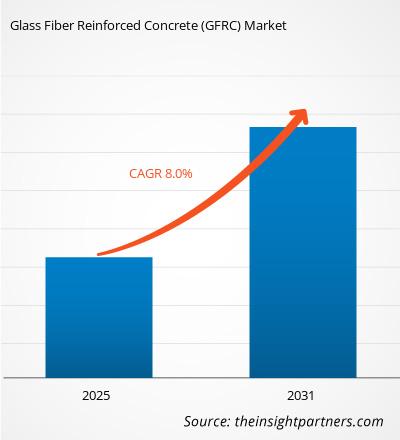Le marché du béton renforcé de fibres de verre (GFRC) devrait enregistrer un TCAC de 8 % de 2024 à 2031, avec une taille de marché passant de XX millions USD en 2024 à XX millions USD d'ici 2031.
Le rapport est segmenté par processus (pulvérisation, prémélange, hybride). L'analyse globale est ensuite ventilée au niveau régional et par principaux pays. Le rapport présente en outre une analyse basée sur l'application (application commerciale, construction résidentielle, génie civil et autres infrastructures). L'analyse globale est ensuite ventilée au niveau régional et par principaux pays. La taille du marché et les prévisions aux niveaux mondial, régional et national pour tous les segments de marché clés sont couvertes dans le cadre du périmètre. Le rapport offre la valeur en USD pour l'analyse et les segments ci-dessus. Le rapport fournit des statistiques clés sur l'état du marché des principaux acteurs du marché et offre des tendances et des opportunités de marché.
Objectif du rapport
Le rapport sur le marché du béton renforcé de fibres de verre (GFRC) de The Insight Partners vise à décrire le paysage actuel et la croissance future, les principaux facteurs moteurs, les défis et les opportunités. Cela fournira des informations à diverses parties prenantes commerciales, telles que :
- Fournisseurs/fabricants de technologie : pour comprendre l’évolution de la dynamique du marché et connaître les opportunités de croissance potentielles, leur permettant de prendre des décisions stratégiques éclairées.
- Investisseurs : Effectuer une analyse complète des tendances concernant le taux de croissance du marché, les projections financières du marché et les opportunités qui existent tout au long de la chaîne de valeur.
- Organismes de réglementation : Réglementer les politiques et surveiller les activités du marché dans le but de minimiser les abus, de préserver la confiance des investisseurs et de maintenir l’intégrité et la stabilité du marché.
Segmentation du marché du béton renforcé de fibres de verre (GFRC)
Processus
- Pulvérisation
- Prémélange
- Hybride
Application
- Application commerciale
- Construction résidentielle
- Construction civile et autres infrastructures
Personnalisez ce rapport en fonction de vos besoins
Vous bénéficierez d'une personnalisation gratuite de n'importe quel rapport, y compris de certaines parties de ce rapport, d'une analyse au niveau des pays, d'un pack de données Excel, ainsi que de superbes offres et réductions pour les start-ups et les universités.
Marché du béton renforcé de fibres de verre (GFRC) : informations stratégiques

- Obtenez les principales tendances clés du marché de ce rapport.Cet échantillon GRATUIT comprendra une analyse de données, allant des tendances du marché aux estimations et prévisions.
Facteurs de croissance du marché du béton renforcé de fibres de verre (GFRC)
- Popularité croissante du GFRC dans la construction : Le GFRC est un matériau de construction qui présente des avantages notables, par exemple un faible poids, une forte résistance aux charges mécaniques et aux influences externes. Étant donné que la plupart des industries s'orientent vers des alternatives meilleures, plus rapides et moins chères, la popularité du GFRC est en hausse dans le monde entier pour les structures résidentielles et commerciales, en particulier pour les façades, mais aussi pour les sculptures et les éléments décoratifs.
- Progrès technologiques dans la production de béton armé : L'amélioration de ces technologies dans la production de béton armé, par exemple l'amélioration du mélange de fibres et le contrôle du processus de durcissement, a amélioré ses propriétés. Ces développements obligent les architectes et les constructeurs à considérer plus facilement le béton armé comme un matériau de fond structurel léger, facile à travailler et solide.
- Durabilité et attrait esthétique du GFRC : On observe également une augmentation de la demande de matériaux de construction écologiques et esthétiques dans le domaine de l'approvisionnement en GFRC. Étant donné que le GFRC permet la construction de divers motifs et formes détaillés, il est largement utilisé pour les éléments de revêtement mural décoratif et les piliers, les statues artistiques et les enceintes de bâtiments. De plus, sa faible teneur en carbone et sa durabilité en font un matériau de prédilection pour l'architecture durable.
Tendances futures du marché du béton renforcé de fibres de verre (GFRC)
- Croissance du marché du béton préfabriqué et construction modulaire : La croissance du marché du béton préfabriqué sera également liée à l'adoption croissante des technologies de construction préfabriquée et modulaire. Les caractéristiques du béton préfabriqué, telles que sa légèreté, ses possibilités de personnalisation et sa durabilité, en font un matériau adapté aux méthodes de construction qui recherchent le temps et l'efficacité. Cette tendance va très probablement accroître son utilisation dans les infrastructures urbaines ainsi que dans les projets de logements de grande envergure.
- La durabilité favorise l'adoption du béton préfabriqué en béton armé : Un autre facteur qui aura un impact positif sur le marché du béton préfabriqué en béton armé est la durabilité. Avec le durcissement de la loi, l'attention se portera sur l'utilisation de matériaux durables. Cela devrait répondre aux préoccupations futures, compte tenu de la démographie et de la géolocalisation des projets en cours, le béton préfabriqué en béton armé étant déjà considéré comme un béton « vert », offrant une empreinte carbone négative plus faible, plus recyclable et plus durable.
- Conceptions architecturales sophistiquées et potentiel décoratif du GFRC : Avec la sophistication accrue des conceptions architecturales, les façades ont évolué vers des conceptions plus élaborées et sur mesure, ce qui rend le GFRC hautement décoratif en raison de sa capacité à prendre des formes différentes et complexes. La demande de GFRC dans les bâtiments résidentiels et commerciaux de luxe devrait permettre une réplication haut de gamme sans perte de fidélité structurelle.
Opportunités de marché du béton renforcé de fibres de verre (GFRC)
- Le béton préfabriqué en béton armé dans la construction modulaire : à mesure que la construction évolue vers des méthodes plus rapides et plus efficaces, les propriétés légères, durables et personnalisables du béton préfabriqué en béton armé en font un matériau idéal pour la construction préfabriquée et modulaire. La tendance à utiliser des composants de construction préfabriqués hors site, plus faciles à transporter et à assembler, devrait entraîner une croissance significative du marché du béton préfabriqué en béton armé.
- Durabilité et impact environnemental : Les gouvernements et les entreprises accordent de plus en plus d'importance aux pratiques de construction durables. Le faible impact environnemental et la longue durée de vie du GFRC en font un choix approprié. L'utilisation du GFRC dans les infrastructures respectueuses de l'environnement, telles que les bâtiments verts et les espaces publics, devrait augmenter à mesure que la demande de matériaux durables dans la construction continue d'augmenter.
- Applications esthétiques et architecturales : Le GFRC est de plus en plus utilisé dans les applications décoratives et architecturales, notamment pour les bardages, les façades et les éléments ornementaux. Avec la tendance vers des bâtiments plus complexes et personnalisés sur le plan esthétique, le GFRC offre une flexibilité de conception, offrant aux architectes la possibilité de créer des structures uniques et durables nécessitant peu d'entretien. Cela crée une opportunité croissante dans la construction résidentielle et commerciale.
Aperçu régional du marché du béton renforcé de fibres de verre (GFRC)
Les tendances et facteurs régionaux influençant le marché du béton renforcé de fibres de verre (GFRC) tout au long de la période de prévision ont été expliqués en détail par les analystes d’Insight Partners. Cette section traite également des segments et de la géographie du marché du béton renforcé de fibres de verre (GFRC) en Amérique du Nord, en Europe, en Asie-Pacifique, au Moyen-Orient et en Afrique, ainsi qu’en Amérique du Sud et en Amérique centrale.

- Obtenez les données régionales spécifiques au marché du béton renforcé de fibres de verre (GFRC)
Portée du rapport sur le marché du béton renforcé de fibres de verre (GFRC)
| Attribut de rapport | Détails |
|---|---|
| Taille du marché en 2024 | XX millions de dollars américains |
| Taille du marché d'ici 2031 | XX millions de dollars américains |
| Taux de croissance annuel composé mondial (2025-2031) | 8% |
| Données historiques | 2021-2023 |
| Période de prévision | 2025-2031 |
| Segments couverts | Par processus
|
| Régions et pays couverts | Amérique du Nord
|
| Leaders du marché et profils d'entreprises clés |
|
Acteurs du marché du béton renforcé de fibres de verre (GFRC) Densité : comprendre son impact sur la dynamique commerciale
Le marché du béton renforcé de fibres de verre (GFRC) connaît une croissance rapide, tirée par la demande croissante des utilisateurs finaux en raison de facteurs tels que l'évolution des préférences des consommateurs, les avancées technologiques et une plus grande sensibilisation aux avantages du produit. À mesure que la demande augmente, les entreprises élargissent leurs offres, innovent pour répondre aux besoins des consommateurs et capitalisent sur les tendances émergentes, ce qui alimente davantage la croissance du marché.
La densité des acteurs du marché fait référence à la répartition des entreprises ou des sociétés opérant sur un marché ou un secteur particulier. Elle indique le nombre de concurrents (acteurs du marché) présents sur un espace de marché donné par rapport à sa taille ou à sa valeur marchande totale.
Les principales entreprises opérant sur le marché du béton renforcé de fibres de verre (GFRC) sont :
- Ciment Ultratech Ltée.
- Produits Formglas Ltée
- Willis Construction Co. Inc
- Clark Pacifique
- Amoureux
Avis de non-responsabilité : les sociétés répertoriées ci-dessus ne sont pas classées dans un ordre particulier.

- Obtenez un aperçu des principaux acteurs du marché du béton renforcé de fibres de verre (GFRC)
Principaux arguments de vente
- Couverture complète : Le rapport couvre de manière exhaustive l’analyse des produits, des services, des types et des utilisateurs finaux du marché du béton renforcé de fibres de verre (GFRC), offrant un paysage holistique.
- Analyse d’experts : Le rapport est compilé sur la base d’une compréhension approfondie des experts et analystes du secteur.
- Informations à jour : Le rapport garantit la pertinence commerciale en raison de sa couverture des informations récentes et des tendances des données.
- Options de personnalisation : ce rapport peut être personnalisé pour répondre aux exigences spécifiques du client et s'adapter parfaitement aux stratégies commerciales.
Le rapport de recherche sur le marché du béton renforcé de fibres de verre (GFRC) peut donc aider à ouvrir la voie au décodage et à la compréhension du scénario de l’industrie et des perspectives de croissance. Bien qu’il puisse y avoir quelques préoccupations valables, les avantages globaux de ce rapport ont tendance à l’emporter sur les inconvénients.
- Analyse historique (2 ans), année de base, prévision (7 ans) avec TCAC
- Analyse PEST et SWO
- Taille du marché Valeur / Volume - Mondial, Régional, Pays
- Industrie et paysage concurrentiel
- Ensemble de données Excel



Report Coverage
Revenue forecast, Company Analysis, Industry landscape, Growth factors, and Trends

Segment Covered
This text is related
to segments covered.

Regional Scope
North America, Europe, Asia Pacific, Middle East & Africa, South & Central America

Country Scope
This text is related
to country scope.
Questions fréquemment posées
Adoption in precast and modular construction is expected to be the key market trends
Based on geography, Asia Pacific held the largest share of the glass fiber reinforced concrete (GFRC) market due to the well-established construction industry across the region, coupled with continuous growth and development
Based on process, the spraysegment is expected to witness the fastest growth during the forecast period
Increasing demand for lightweight and durable construction materials is driving the market growth
BASF SE
; Saint-Gobain Weber
; Ply Gem
; Sika AG
; GFRG Technologies Pvt. Ltd.
; Cemex S.A.B. de C.V.
; Freyssinet Limited
; Huntsman Corporation
; Concrete Technology
; Aditya Birla Chemicals
; UltraTech Cement
; Wacker Chemie AG
; BASF Construction Chemicals
; Technocrete
; Alabama Structural Products
The Glass Fiber Reinforced Concrete (GFRC) Market is estimated to witness a CAGR of 8% from 2023 to 2031
Trends and growth analysis reports related to Chemicals and Materials : READ MORE..
List of Companies
1. Ultratech Cement Ltd.
2. Formglas Products Ltd
3. Willis Construction Co. Inc
4. Clark Pacific
5. Loveld
6. Fibrex
7. Betofiber A.S
8. Stromberg Architectural
9. BB fiberbeton A/S
10. Nanjing Beilida New Material System Engineering Co., Ltd.
The Insight Partners performs research in 4 major stages: Data Collection & Secondary Research, Primary Research, Data Analysis and Data Triangulation & Final Review.
- Data Collection and Secondary Research:
As a market research and consulting firm operating from a decade, we have published and advised several client across the globe. First step for any study will start with an assessment of currently available data and insights from existing reports. Further, historical and current market information is collected from Investor Presentations, Annual Reports, SEC Filings, etc., and other information related to company’s performance and market positioning are gathered from Paid Databases (Factiva, Hoovers, and Reuters) and various other publications available in public domain.
Several associations trade associates, technical forums, institutes, societies and organization are accessed to gain technical as well as market related insights through their publications such as research papers, blogs and press releases related to the studies are referred to get cues about the market. Further, white papers, journals, magazines, and other news articles published in last 3 years are scrutinized and analyzed to understand the current market trends.
- Primary Research:
The primarily interview analysis comprise of data obtained from industry participants interview and answers to survey questions gathered by in-house primary team.
For primary research, interviews are conducted with industry experts/CEOs/Marketing Managers/VPs/Subject Matter Experts from both demand and supply side to get a 360-degree view of the market. The primary team conducts several interviews based on the complexity of the markets to understand the various market trends and dynamics which makes research more credible and precise.
A typical research interview fulfils the following functions:
- Provides first-hand information on the market size, market trends, growth trends, competitive landscape, and outlook
- Validates and strengthens in-house secondary research findings
- Develops the analysis team’s expertise and market understanding
Primary research involves email interactions and telephone interviews for each market, category, segment, and sub-segment across geographies. The participants who typically take part in such a process include, but are not limited to:
- Industry participants: VPs, business development managers, market intelligence managers and national sales managers
- Outside experts: Valuation experts, research analysts and key opinion leaders specializing in the electronics and semiconductor industry.
Below is the breakup of our primary respondents by company, designation, and region:

Once we receive the confirmation from primary research sources or primary respondents, we finalize the base year market estimation and forecast the data as per the macroeconomic and microeconomic factors assessed during data collection.
- Data Analysis:
Once data is validated through both secondary as well as primary respondents, we finalize the market estimations by hypothesis formulation and factor analysis at regional and country level.
- Macro-Economic Factor Analysis:
We analyse macroeconomic indicators such the gross domestic product (GDP), increase in the demand for goods and services across industries, technological advancement, regional economic growth, governmental policies, the influence of COVID-19, PEST analysis, and other aspects. This analysis aids in setting benchmarks for various nations/regions and approximating market splits. Additionally, the general trend of the aforementioned components aid in determining the market's development possibilities.
- Country Level Data:
Various factors that are especially aligned to the country are taken into account to determine the market size for a certain area and country, including the presence of vendors, such as headquarters and offices, the country's GDP, demand patterns, and industry growth. To comprehend the market dynamics for the nation, a number of growth variables, inhibitors, application areas, and current market trends are researched. The aforementioned elements aid in determining the country's overall market's growth potential.
- Company Profile:
The “Table of Contents” is formulated by listing and analyzing more than 25 - 30 companies operating in the market ecosystem across geographies. However, we profile only 10 companies as a standard practice in our syndicate reports. These 10 companies comprise leading, emerging, and regional players. Nonetheless, our analysis is not restricted to the 10 listed companies, we also analyze other companies present in the market to develop a holistic view and understand the prevailing trends. The “Company Profiles” section in the report covers key facts, business description, products & services, financial information, SWOT analysis, and key developments. The financial information presented is extracted from the annual reports and official documents of the publicly listed companies. Upon collecting the information for the sections of respective companies, we verify them via various primary sources and then compile the data in respective company profiles. The company level information helps us in deriving the base number as well as in forecasting the market size.
- Developing Base Number:
Aggregation of sales statistics (2020-2022) and macro-economic factor, and other secondary and primary research insights are utilized to arrive at base number and related market shares for 2022. The data gaps are identified in this step and relevant market data is analyzed, collected from paid primary interviews or databases. On finalizing the base year market size, forecasts are developed on the basis of macro-economic, industry and market growth factors and company level analysis.
- Data Triangulation and Final Review:
The market findings and base year market size calculations are validated from supply as well as demand side. Demand side validations are based on macro-economic factor analysis and benchmarks for respective regions and countries. In case of supply side validations, revenues of major companies are estimated (in case not available) based on industry benchmark, approximate number of employees, product portfolio, and primary interviews revenues are gathered. Further revenue from target product/service segment is assessed to avoid overshooting of market statistics. In case of heavy deviations between supply and demand side values, all thes steps are repeated to achieve synchronization.
We follow an iterative model, wherein we share our research findings with Subject Matter Experts (SME’s) and Key Opinion Leaders (KOLs) until consensus view of the market is not formulated – this model negates any drastic deviation in the opinions of experts. Only validated and universally acceptable research findings are quoted in our reports.
We have important check points that we use to validate our research findings – which we call – data triangulation, where we validate the information, we generate from secondary sources with primary interviews and then we re-validate with our internal data bases and Subject matter experts. This comprehensive model enables us to deliver high quality, reliable data in shortest possible time.

 Obtenez un échantillon gratuit pour ce rapport
Obtenez un échantillon gratuit pour ce rapport